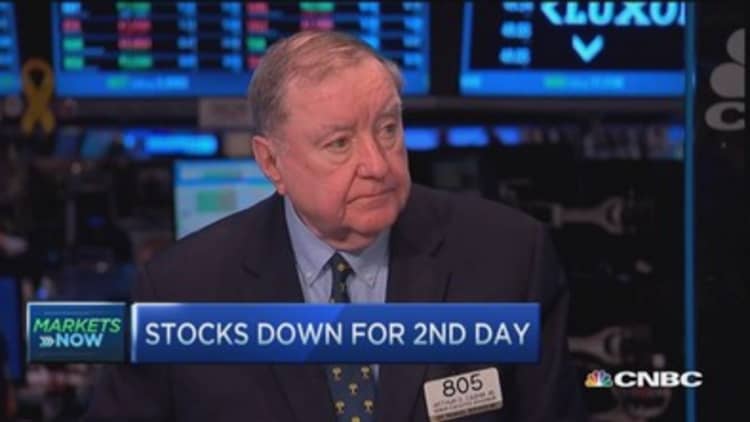


U.S. stocks closed lower on Wednesday amid a series of economic data that continued to show moderate growth ahead of Friday's key jobs report.
Investors also eyed the European Central Bank meeting on Thursday that might reveal details on the timing of the bond-buying program announced earlier in the year.
Wednesday's decline "is a combination of three days in a row of data that's not terrible but it's not good, and heading into the big jobs report," said JJ Kinahan, chief derivatives strategist at TD Ameritrade. "We're right off all-time highs. (The big question was) can we rally back and close above 2,100?"
The S&P 500 closed just under 2,100 as all sectors except health care declined. The Dow Jones industrial average closed down 106 points after earlier falling more than 150 points, with most blue chips lagging.
Stocks held to earlier declines despite the Fed's Beige Book showing optimism on an expanding economy in most regions, with some pressure from energy and winter weather. The report also said there are some wage hikes in separate industries.
"I think it's a friendly survey, but the market's not reacting at this time," said Peter Cardillo, chief market economist at Rockwell Global Capital. "For the markets, it's probably a non-event."
Taking "the Beige Book in the context of other data, you see the consumer driving growth," said Robin Anderson, economist at Principal Global Investors.
Earlier, the ADP private payrolls report showed a gain of 212,000 in February, below expectations and the slowest pace since August 2014. The January private payrolls report was revised up to 250,000.
Bob Gavlak, wealth advisor with Strategic Wealth Partners, said that Wednesday's selloff was "overreaction to the fact that job growth seems to have slowed down."
Read MoreThis is what to watch before Friday's jobs report
The ADP data is considered a pre-indicator of Friday's labor market report from the Bureau of Labor Statistics.
"Bottom line, job growth slowed in February but ADP revised up its previous years data which puts it more in line with what the BLS has been saying," Peter Boockvar, chief market analyst at The Lindsey Group, said in a note.
The Federal Reserve should wait until the first half of 2016 before raising interest rates, said, citing low inflation.
Art Hogan, chief market strategist at Wunderlich Securities, noted that since Evans has a track record of dovish statements, "when he says something dovish it shouldn't matter and probably shouldn't change our impression of Fed speakers going forward."
Hawkish Kansas City Fed President Esther George said the U.S. economy was approaching full employment and that the central bank should raise interest rates in the middle of this year.
At a conference in Kansas City, George said she was "not overly concerned" with recent weak inflation, which has been dragged lower by the drop in oil prices. Rising rents and some evidence of wage increases would likely mean a return to higher inflation in the future, she said.
The for February, above estimates of 56.5.
Read MoreDuring crisis, Yellen among biggest Fed pessimists
Stocks pulled back from records on Tuesday, with the Dow and S&P lower and the Nasdaq below the psychologically important 5,000 level.
"Every time you reach a record high you get a bit of profit-taking and consolidation before you reach the next wave," said Randy Frederick, managing director of trading and derivatives at Charles Schwab.
He said the important figure for the Nasdaq is not the 5,000 level topped on Monday but the closing high of 5,048, which he said the index could reach "within the next week."
Rockwell's Cardillo expects indices to stay within a range in the short term ahead of the FOMC meeting and quarterly options expirations. "We think this range-bound scenario will give investors a chance to raise cash ahead of a late March—April pullback," he said in a note.
Growth in the U.S. services sector accelerated modestly in February, lifted by improvements in new business, Markit said. The final reading of its Purchasing Managers Index for the services sector rose to 57.1 in February, its highest level since October. The reading was roughly even with the preliminary read of 57.0 but up from the 54.2 recorded in January.
Major U.S. Indexes
The Dow Jones Industrial Average closed down 106 points, or 0.58 percent, to 18,096.90, with American Express the greatest laggard and UnitedHealth leading six advancers.
The closed down 9.25 points, or 0.44 percent, to 2,098.53, with telecommunications the greatest decliner and health care the only sector of the ten advancing.
The Nasdaq closed down 12.7 points, or 0.26 percent, at 4,967.14.
Three stocks declined for every two advancers on the New York Stock Exchange, with an exchange volume of 723 million and a composite volume of 3.4 billion in the close.
The CBOE Volatility Index (VIX), widely considered the best gauge of fear in the market, traded near 14.
The U.S. 10-year Treasury yield traded near 2.11 percent. The U.S. dollar traded higher against major world currencies, while the euro fell to lows below $1.11 ahead of the ECB meeting.
Read MoreRare McDonald's bull expects super-sized gains
In oil markets, Brent crude traded around $60 per barrel on Wednesday after Saudi Arabia raised its official selling prices for its oil deliveries to Asia and the U.S. on Tuesday. In the past seven weeks, Brent crude has risen from a six-year low of around $45, despite global oversupply concerns.
The U.S. Energy Information Administration reported that weekly crude oil inventories rose 10.3 million barrels.
Crude oil futures settled up $1.01, or 2 percent, to $51.53 a barrel on the New York Stock Exchange. Gold futures settled down $3.50 to $1,200.90 an ounce.
Abercrombie & Fitch posted results that matched estimates but quarterly profit fell by a third. PetSmart reported earnings that beat on both the top and bottom lines.
Smith & Wesson earned an adjusted 20 cents per share for its latest quarter, 9 cents above estimate, and revenue was also above analyst forecasts. Smith & Wesson also raised its guidance for the full year on rebounding demand for consumer handguns.
Read MoreEarly movers: MCD, GE, LL, GME, TGT & more
Bob Evans Farms has decided not to sell or spin off its foods unit, although it has hired JPMorgan Chase to advise on options for its real estate. Bob Evans also reported a weaker than expected profit for its latest quarter, earning an adjusted 60 cents per share compared to a 71 cent consensus estimate. Revenue also fell short of analyst forecasts.
—Reuters and CNBC.com contributed to this report.
On tap this week:
Wednesday
7:00 p.m.: Fed's Fisher Speaks
Thursday
Chain store sales
ECB Governing Council Press Conference
Earnings: Costco, Canadian Natural Resources, Kroger, JoyGlobal, Cooper Cos., Diamond Foods, Finisar, Quiksilver
7:30 a.m.: Challenger Job-Cut Report
8:30 a.m.: Jobless claims
8:30 a.m.: Productivity & Costs
10 a.m.: Factory orders
10:30 a.m.: Natural gas inventories
4:30 p.m.: Fed balance sheet/Money supply
Friday
Weekly rig count
Earnings: Foot Locker, Staples
8:30 a.m.: Nonfarm payrolls
8:30 a.m.: International trade
3 p.m.: Consumer credit
More From CNBC.com:


